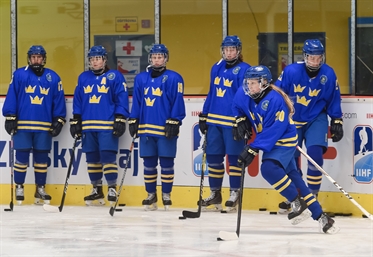Boork’s progress
Boork’s progress
How far can the Swedish team rise?

 ZLIN, CZECH REPUBLIC - JANUARY 7: Team Sweden warms up ahead of preliminary round action against Canada at the 2017 IIHF Ice Hockey U18 Women's World Championship. (Photo by Andrea Cardin/HHOF-IIHF Images)
ZLIN, CZECH REPUBLIC - JANUARY 7: Team Sweden warms up ahead of preliminary round action against Canada at the 2017 IIHF Ice Hockey U18 Women's World Championship. (Photo by Andrea Cardin/HHOF-IIHF Images)
Sweden’s Leif Boork is looking for answers. Boork first made an international name for himself back in 1984 when the rookie coach took Tre Kronor to the finals of the best-of-three Canada Cup against Wayne Gretzky and the Canadians.
Now, more than 33 years later, he stands in a frigid PSG Arena in Zlin as the coach of the women’s national team, scouting the U18 team to see who might make a good fir for next year’s Olympics. “Women’s hockey is difficult,” he said, acknowledging the -12 degree temperature inside.
Although he has been head coach of the women’s senior team for two years, he started working with the program even earlier.
“I was asked by our Olympic Committee before Sochi to help the coaches and the players because we had had some tough years before that,” he started. “We even had to play in the relegation in 2013. The confidence in the team and even among the coaches was not that good, so I tried to instill some confidence in the whole group.”
In truth, the only medals Sweden has won at the Women’s Worlds were in 2005 and 2007, two bronze medals to bookend the fabulous silver they claimed at the Turin Olympics.
Oddly, the U18 team has won bronze in five of the nine tournaments between 2008 and 2016, suggesting the early success does not translate to success at the senior level.
Although Boork cares about the results, it’s the bigger picture that’s more critical, establishing the means for the team to do well every year and develop talent consistently. To that end, Boork worries about that often too big gap between a player’s U18 career and her senior career.
“That’s one of our biggest problems,” he acknowledges. “In Sweden, we don’t have a U20 or U22 team. These girls have to get to the ladies’ senior national team. That can be a huge step for many of them, and many don’t make it.”
This is an inherent advantage the North Americans have. After U18 play they go to NCAA hockey for four years. They can grow and develop, nurture their talent, and get an education. When they graduate, they are much better athletes and have a path to a career in the working world. All is good. Not so in Europe.
“That’s the big question we have in the federation,” Boork continued. “It’s about money. It’s about support and development. What we have now are club teams for girls after the U18, and we let those teams develop the players. From there we select them for the national team. But we try to have camps with 30-35 players for those who have just left the junior level and try to put them with senior players so they can begin to make the adjustment. We’ve had financial help from the Olympic Committee with this, and it’s worked out well.”
But camps don’t develop players. Time, patience, money, support of all kinds are what’s needed. Boork understands the problem but has no immediate solution.
“The problem is that for many players who are very talented but can’t make the senior level right away, they drop off. They go to work. They can’t afford to play and train full time. We have discussed this, and we need to talk to the federation to find the money to keep them. I don’t know what’s in the future. It’s much easier for Canada, as an example, because they get a lot of media money, through TV, to help Hockey Canada finance a lot of what they do as well, so we fall further behind. We don’t have that money.”
In a simple world, you can divide a team into three components: goal, defence, forwards. As we have seen here in the Czech Republic, goaltending can be a huge factor, especially for the European teams. Defence is essential as a means of keeping the game close and competitive. And scoring, of course, is what a team needs to do to win. Boork addresses each as he looks to the future.
“We’ve had a lot of change in our goalies and defence, and we’re trying to get better in those areas,” he admitted. “This will be our focus to recruit and teach these areas. But our goaltending has gotten better, and we now have four or five good ones coming up through the system. Forwards I’m not so worried about. It’s the defencemen that we have to work on.”
In the old days, commitment to training was a huge challenge for the European teams, and this is improving all the time. It not only means players are taking he game more seriously; it means with a better body they can expect to do better things.
“The players’ dedication to their physical well being has improved quite a lot,” Boork said. “Players are better prepared physically. So now, we need to increase the tempo of the players. When you have strength, you can get better skaters, faster skaters, and faster skaters can be better players in all areas of the game.”
The other problem is that the Women’s World Championships and U18 tournaments happen but once a year. That’s not enough to spur development and experience.
“We need more games against the North Americans as well,” Boork emphasized. “So much of playing well at the top level is mental. You have to be able to play well with pressure, one-goal games, tough situations. You need the games.”
Unfortunately for the women’s program, Boork will leave the team after the Olympics next year. “I’m an old man. I’m 68,” he said with an energy that disagreed with his words. But he feels the program is in good shape and perhaps, for the first time, might be ready for a female head coach of the senior team.
“I can see a woman coach, for sure,” he concluded. “We have several good women coaches in the league, so I can absolutely see a woman coaching the team.”
Back to Overview

















































